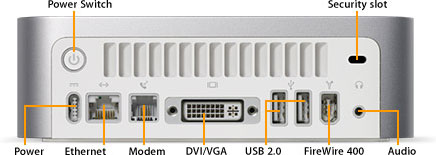2005 – While Apple is busy suing AppleInsider and others over leaks regarding their “Asteroid” project, our unusually reliable source – an illegal immigrant subcontracted to clean Apple’s research labs when she couldn’t get the same kind of work at Walmart – has helped The Rumor Mill scoop all the legitimate rumor sites.

Although Macs are supposed to stay up and running 24/7 and be put to sleep instead of turned off, that’s a problem with Apple’s latest transportable computer. You can’t put a Mac mini to sleep, unplug it, tote it to another location, and then wake it up.
Worse yet, the power switch is inconveniently located on the back of the minuscule Mac. That’s right – not on the front like Power Macs or CRT iMacs, not on the side like eMacs, and not on the top like the ill-fated Cube. You have to reach all the way around the 6.5″ square computer to turn on the power.
Reasoning that the Mac mini is too small to function as a monitor stand – the typical use of desktop computers worldwide (in contrast to tower designs) – Apple’s top technicians and designers have been hard at work on the “Comet” project.

On the back – what a stupid place for a power switch!
The Comet device remedies the mini’s chief design flaw by providing two power buttons – one for on, one for off – conveniently located on top of the computer. And, unlike those on the Cube, they are not so sensitive that waving your hand over them will turn the mini on or off.
 But that’s not all Comet does. It also functions as a portable power supply for the Mac mini. The 10,000 mAh battery inside Comet will provide up to 12 hours of power (AirPort Express off, Bluetooth off, no USB 2.0 or FireWire devices drawing bus power).
But that’s not all Comet does. It also functions as a portable power supply for the Mac mini. The 10,000 mAh battery inside Comet will provide up to 12 hours of power (AirPort Express off, Bluetooth off, no USB 2.0 or FireWire devices drawing bus power).
The 1.75″ high Comet has the same 6.5″ square footprint as the Mac mini and needs never be removed from the computer, so it’s normally attached with model cement.
For those who want to be able to disconnect Comet from the mini, Apple also provides a pair of thin black straps that run in front of and behind the power buttons, then under the Mac mini.
As with the iPod, the battery will be user replaceable, although Apple would much rather sell Comet owners a whole new unit for US$249 – or install a replacement battery for $199 plus shipping. Because of the cost of the replacement battery and the fact that they probably won’t last three years, AppleCare for Comet will sell for $199.
Expect NewerTech and others to offer higher capacity, lower cost batteries long before the included batteries can be expected to wear out.
Apple ignited the personal computer revolution in the 1970s with the Apple II, redefined the personal computer interface in the 1980s with the Macintosh, brought gaudy colors to the personal computer in the 1990s with the tangerine and key lime iBooks, and dominates the digital music player market in the 2000s with the iPod family of products. Apple is committed to building profitable personal computers and consumer entertainment devices for people around the world and selling their bulletproof OS X operating system for much less than Microsoft’s retail price for any current version of Windows.
Comet will be officially released on April 1, 2005, and should be in every Apple Store on that date. Availability to other brick-and-mortar stores will vary depending on which authorized Apple dealers are suing the mothership and which are not.
Steve Jobs was unavailable for comment.
– Anne Onymus

